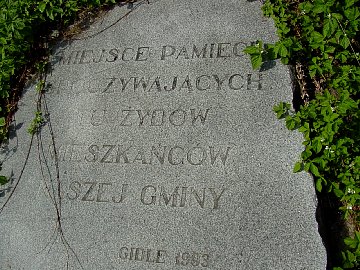Alternate names: Pławno [Pol], Plavno, Плавно [Rus], פלאוונו [Yid]. 50°59' N, 19°28' E, 20 miles NE of Częstochowa, 30 miles SSW of Piotrków Trybunalski, 53 miles S of Łódź. 1900 Jewish population: 752. Pławno is a village in the administrative district of Gmina Gidle within Radomsko powiat, Łódź Voivodeship in central Poland with a population of 1,200. The Jews from Plawno were sent to the ghetto in Radomsko during WWII. [June 2009]
Normal 0
CEMETERY: Located on the edge of the forest in the direction of Zagórze, this cemetery also served Jews from nearby Gidel. Many Chasidic rabbis from Gidel are buried here. The cemetery was destroyed during the Holocaust, followed by destruction after the war. Locals gradually stole the stone fence and gravestones until the cemetery became an illegal rubbish and scrap dump. In the late 1980s, the Society of Gidel Friends decided to end the indignity to the burial place of their former Jewish neighbors. The cemetery was cleaned. Four 19th and early 20th century damaged matzevot with carved candles and plant motifs became a small and simple lapidarium. A plaque was placed reading: "Memorial to the Jews - citizens of our municipality. Gidle 1993. The unveiling the monument included members of the Society of Friends Gidel, local authorities, Jewish representatives, and pupils and teachers from local schools. [June 2009]
US Commission No. AS 174
Plawno is located in the Czestochowa region at 50º5919º28, 35 km from Czestochowa and 3 km from Radomsko. The cemetery is located E from the town. Present town population is 1,000-5,000 with no Jews.
- Town: Plawno is Urzad Gminy Gidle, tel. 1-12-27.
- Regional: region Konserwator Zabytkow, Czestochowa ul. Domagalskich 2, tel. 49745.
1921 Orthodox Jewish population was 556. The isolated rural (agricultural) flat land has no sign or marker, no wall, gate, or fence. Reached by turning directly off a public road, access is open to all. 1-20 gravestones visible in the cemetery; not all in original position and more than 75% of them toppled or broken, date from 1840-20th centuries. The sandstone flat shaped stones have Hebrew inscriptions. The cemetery contains no known mass graves. Municipality owns site used for waste dumping. Properties adjacent are agricultural. Compared to 1939, the cemetery boundaries enclose the same area. Local residents visit rarely. The cemetery was not vandalized in the last ten years. No maintenance. No structures. There are moderate security and vandalism threats (destroyed and defaced).
Jan Pawet Woronczak, Sandomierska Str. 21m.1, 02-561, Warszawa, tel. 49-54-62, visited cemetery in 1984 with Tery Woronczak and completed survey on November 10, 1991.
UPDATE: Little remains, just three tombstones in excellent condition that were likely moved or re-erected. I took digital jpgs, about 800K each, of these three stones. Source: Daniel Kazez on JewishGen Digest. [May 2002]
UPDATE: Burial list is at http://www.crarg.org/ [August 2005].
Photographs by Daniel Kazez This email address is being protected from spambots. You need JavaScript enabled to view it.


